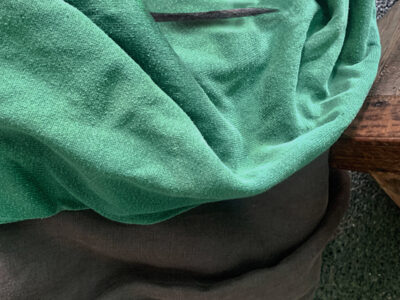Allergen
Being a Couch Potato
We have yet to come across “couch potato” in a patch test tray and we’re believers in the occasional let-it-all-go-the-couch-is-my-home-for-a-few-days-don’t-judge-me-or-my-unshowered-self indulgence. It can be a form of de-stressing. Stress is inflammatory. Ergo, if being a couch potato helps you de-stress, it is good. As with many things, however, this is true if you indulge in moderation. If it remains a treat — as opposed to your daily norm — couch potato-ing has our vote. But it does come with its fair share of allergen exposure:
The Furniture Itself
This beloved piece of furniture can be a minefield if you’ve patch tested positive to dyes, certain textiles, or latex (the foam can be an issue). When couch shopping, look for untreated fabrics (organic, even) in white or very pale colors, or uncolored. In addition to having less allergens, natural fabrics tend to breathe more, allowing for better air circulation and less trapped heat. Heat and sweat can increase the chances of a reaction. Another reason to choose natural over synthetic fabrics: formaldehyde is commonly used to preserve upholstery, especially synthetic fabrics. Formaldehyde is both an irritant and an allergen. For new couches, let them “breathe out” the formaldehyde by placing them in a well ventilated room with open windows or air them out on the terrace.
If your allergies developed later, consider getting a slipcover or large cloth in an untreated canvas (or other untreated, uncolored fabric) to serve as a barrier between you and the sofa.
Cleaning
Most fabric cleaners are scented and contain other allergens like preservatives. If you can’t find a hypoallergenic option, try mixing your own in a spray bottle. Take about 1/4 cup of clear vinegar and add 1/2 a tablespoon of Fawn & Launder or any of our hypoallergenic shampoos, and 3/4 cup warm water. Shake well in the bottle. Spray the sofa and grab a soft, white, cotton cloth to scrub in circular motions. Rinse the cloth and moisten it with clean, warm water. Repeat the circular motion to rinse.
If you’re using a slipcover, wash it with Fawn & Launder. If you’re using a non-hypoallergenic laundry detergent, line dry whenever possible. This kills more microbes and helps remove leftover chlorine and other chemicals from fabric treatments.
Dust mites
A dust mite allergy is not a skin allergy but it can irritate the skin and cause itching. Like food and pet allergies, a dust mite allergy functions differently (type B cells) from skin allergies (type T cells are involved). A skin prick test will show you if you are allergic to dust mites, and a skin patch test tells you if you can come into contact with dust mites (more accurately, with a protein in their feces). For management, dust your couch often, using a moistened duster which picks up more particles than when a dry one. Vacuum your sofa, slipcovers, throws, and pillows frequently — use a vacuum with a HEPA filter. Wash and dry pillowcases, throws and slipcovers every week.
Other Not-Good Things For Your Skin
The above are just the top contact allergens. There other unhealthy things for your skin:
- Couch potato-ing these days means being on your phone a lot. The visible light emitted by your phone — and tablet, monitor, TV, reading light, and other indoor lights — causes hyperpigmentation.
- Chronic contact with a couch with your allergens can also cause pigmented contact dermatitis. PCD is more common in people with darker or mixed phototypes. It can be misdiagnosed because it does not go through the usual redness, then itching and thickening of the skin. Instead, over time the skin just darkens. People don’t usually complain about it or see a doctor for it because PCD develops slowly over time. What can help with a diagnosis is looking at skin darkening on the areas of contact with things that you don’t tend to think you come into contact with as much…such as the couch. This is more true where your exposed skin comes into contact with the couch. Wearing clothing that covers you up more may help unless the clothing itself contains your allergens.
- Hours on the couch can also promote bad eating, poor sleep, and lack of exercise, all of which are inflammatory. Inflammation can cause acne and trigger flare-ups.
So yes, especially when things get really stressful, do couch potato occasionally. But keep it occasional and mindful of allergens you may come into contact with so that you can prepare accordingly and prevent skin problems.
If you have a history of sensitive skin, don’t guess: random trial and error can cause more damage. Ask your dermatologist about a patch test.
To shop our selection of hypoallergenic products, visit vmvhypoallergenics.com. Need help? Ask us in the comments section below, or for more privacy (such as when asking us to customize recommendations for you based on your patch test results) contact us by email, or drop us a private message on Facebook.
For more:
On the prevalence of skin allergies, see Skin Allergies Are More Common Than Ever and One In Four Is Allergic to Common Skin Care And Cosmetic Ingredients.
To learn more about the VH-Rating System and hypoallergenicity, click here.
Main References:
Regularly published reports on the most common allergens by the North American Contact Dermatitis Group and European Surveillance System on Contact Allergies (based on over 28,000 patch test results, combined), plus other studies. Remember, we are all individuals — just because an ingredient is not on the most common allergen lists does not mean you cannot be sensitive to it, or that it will not become an allergen. These references, being based on so many patch test results, are a good basis but it is always best to get a patch test yourself.
2. W Uter et al. The European Baseline Series in 10 European Countries, 2005/2006–Results of the European Surveillance System on Contact Allergies (ESSCA). Contact Dermatitis 61 (1), 31-38.7 2009
3. Wetter, DA et al. Results of patch testing to personal care product allergens in a standard series and a supplemental cosmetic series: An analysis of 945 patients from the Mayo Clinic Contact Dermatitis Group, 2000-2007. J Am Acad Dermatol. 2010 Nov;63(5):789-98.
4. Verallo-Rowell VM. The validated hypoallergenic cosmetics rating system: its 30-year evolution and effect on the prevalence of cosmetic reactions. Dermatitis 2011 Apr; 22(2):80-97
5. Ruby Pawankar et al. World Health Organization. White Book on Allergy 2011-2012 Executive Summary.
6. Misery L et al. Sensitive skin in the American population: prevalence, clinical data, and role of the dermatologist. Int J Dermatol. 2011 Aug;50(8):961-7.
7. Warshaw EM1, Maibach HI, Taylor JS, Sasseville D, DeKoven JG, Zirwas MJ, Fransway AF, Mathias CG, Zug KA, DeLeo VA, Fowler JF Jr, Marks JG, Pratt MD, Storrs FJ, Belsito DV. North American contact dermatitis group patch test results: 2011-2012.Dermatitis. 2015 Jan-Feb;26(1):49-59.
8. Warshaw, E et al. Allergic patch test reactions associated with cosmetics: Retrospective analysis of cross-sectional data from the North American Contact Dermatitis Group, 2001-2004. J AmAcadDermatol 2009;60:23-38.
9. Foliaki S et al. Antibiotic use in infancy and symptoms of asthma, rhinoconjunctivitis, and eczema in children 6 and 7 years old: International Study of Asthma and Allergies in Childhood Phase III. J Allergy Clin Immunol. 2009 Nov;124(5):982-9.
10. Kei EF et al. Role of the gut microbiota in defining human health. Expert Rev Anti Infect Ther. 2010 Apr; 8(4): 435–454.
11. Thavagnanam S et al. A meta-analysis of the association between Caesarean section and childhood asthma. Clin Exp Allergy. 2008;38(4):629–633.
12. Marks JG, Belsito DV, DeLeo VA, et al. North American Contact Dermatitis Group patch-test results, 1998 to 2000. Am J Contact Dermat. 2003;14(2):59-62.
13. Warshaw EM, Belsito DV, Taylor JS, et al. North American Contact Dermatitis Group patch test results: 2009 to 2010. Dermatitis. 2013;24(2):50-99.
Want more great information on contact dermatitis? Check out the American Contact Dermatitis Society, Dermnet New Zealand, and your country’s contact dermatitis association.
 Laura is our “dew”-good CEO at VMV Hypoallergenics and eldest daughter of VMV’s founding dermatologist-dermatopathologist. She has two children, Madison and Gavin, and works at VMV with her sister CC and husband Juan Pablo (Madison and Gavin frequently volunteer their “usage testing” services). In addition to saving the world’s skin, Laura is passionate about health, inclusion, cultural theory, human rights, happiness, and spreading goodness (like a great cream!)
Laura is our “dew”-good CEO at VMV Hypoallergenics and eldest daughter of VMV’s founding dermatologist-dermatopathologist. She has two children, Madison and Gavin, and works at VMV with her sister CC and husband Juan Pablo (Madison and Gavin frequently volunteer their “usage testing” services). In addition to saving the world’s skin, Laura is passionate about health, inclusion, cultural theory, human rights, happiness, and spreading goodness (like a great cream!)



